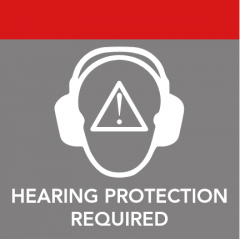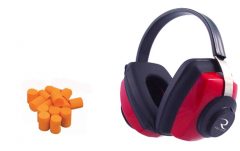Noise Hazards
Noise is one of the most common physical hazards present in the occupational setting. Depending on frequency, amplitude (volume) and duration of exposure, hearing protection may be required. Inadequate hearing protection or prolonged exposure to noise can result in either temporary or permanent hearing loss.
Machinery and equipment are the most likely sources of hazardous noise in the workplace.
Carleton’s Hearing Conservation Program outlines the steps taken by Environmental Health & Safety to reduce noise exposure as well as the responsibilities of supervisors and workers. The program applies to all faculty, staff, students and visitors of Carleton University.
How loud is too loud?
Potentially noise-hazardous areas on campus are evaluated using a noise dosimeter. The results of the latest audit can be found in the appendix of the Hearing Conservation Program.
Noise is measured in decibels (dB), a logarithmic unit. That is to say that 70 dB is twice as loud as 60dB, and 1/4 the loudness of 90 dB.
The occupational exposure limit (OEL) for noise is set at a time-weighted average (TWA) of 85dB. The time-weighted average takes into account noise fluctuations over the course of a normal workday and provides an acceptable average for 8 hours of exposure. Consult the CCOHS – Occupational Noise Fact Sheet for more information.
Below you will find examples of familiar noise sources and their average decibel readings.
| Object | Noise | |
|---|---|---|
| Muffled conversation in office setting | 60 dB | fairly quiet. |
| Vacuum cleaner | 70 dB | consider “nuisance level” noise to most people. |
| Food blender | 80 dB | Twice as loud as 70 dB. Hearing protection is recommended for extended exposure. |
| Lawn mower, motorcycle at 25ft | 90 dB | Hearing protection is required to conserve hearing. |
| Jet take off at 300 m | 100 dB | Serious hearing damage without protection. |
| Chain Saw | 120 dB | Potentially painful without protection. |
| Jet take off at 25 m | 150 dB | Potential for ear drum rupture. |
If you believe that there are potential noise hazards in your work space, please contact the Environmental Health & Safety office.
Signage
Noise hazard signage indicating the need for hearing protection, is posted at all entrances to areas in which the noise levels regularly exceed the Occupational Exposure Limit of 85 dB.

In areas where noise levels approach or exceed 100dB, double hearing protection (both earmuffs and earplugs) is required.
Hearing Protection

Hearing protection is rated for its ability to decrease noise exposure (Noise Reduction Rating (NRR)). You must wear hearing protection with an adequate NRR for the noise exposure encountered.
While hearing protection comes in a variety of shapes and styles, ear plugs and ear muffs with NRRs between 25-30 dB are most often used at Carleton. All hearing protection devices must be CSA approved.
EHS will assist with the selection of appropriate hearing protection for your environment.
The video below describes how to properly insert earplugs to allow for maximum protection.